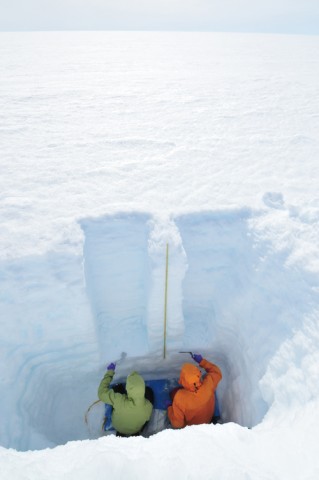A new study has found that the warming of Greenland is speeding changes to the crystalline structure of the fallen snow there in such a way that the snowpack more readily absorbs solar energy. This transformation, in turn, is contributing to more warming of the vast Greenland ice sheet, the researchers report, which further accelerates the transformation to more-heat-absorbent snow.
Ultimately, this vicious cycle is playing a major role in the growing losses of snow and ice from the region, said coauthor Sarah Doherty, an atmospheric scientist at the University of Washington in Seattle. She and her colleagues published their results last Thursday in The Cryosphere.
Although snow falls as the spiky ice crystals we call snowflakes, those tiny grains of ice tend to become rounded and merge together to form bigger grains once they’ve landed. As Greenland’s climate warms, merging of grains happens quicker, Doherty explained. Because larger grains don’t have as many crystal boundaries or as rough textures, they bounce sunlight back into space less effectively than finer-grained snow would, especially sunlight in the invisible, near-infrared wavelengths (700 to 2500 nanometers) that make up half the solar energy Earth receives. Instead, the light gets absorbed as heat, which melts the ice.
“You have a self-reinforcing mechanism,” said Doherty. “When you have larger snow grains, you end up with a darker snowpack—it is actually absorbing more sunlight, which accelerates melting.”
Melting of the Greenland ice sheet could ultimately threaten many of the world’s major coastal cities because of the sea level rise it would cause globally. The deluge of fresh meltwater entering the sea could also disrupt ocean circulation patterns and harm marine organisms, members of this study’s team added.
Black Carbon Decline
Scientists previously thought that much of recent high melting rates on Greenland’s ice sheet stemmed from black carbon settling on the snow, blown in from countries farther south. This carbon—aerosolized pollution and soot from wildfires—would also limit snow’s ability to reflect sunlight, causing melting. But, in fact, the amount of black carbon in the air—which is monitored by stations throughout the Arctic—has been slowly declining in recent decades after peaking in about 1910, according to a 2007 paper published in Science.

Declines in black carbon reaching Greenland do not mean that particulates don’t play a role, the researchers noted. As the top layer of snow melts, it leaves behind a deposit of tiny particles that were trapped inside it. This dark debris in the snow further reduces the reflectivity of the ice, increases warming, and causes more melting. Every layer that melts adds more particulates to the layer below it, compounding the issue.
Melting snow also exposes more dirt. That dirt can get picked up by the wind and deposited onto the ice, which also makes it melt faster, Doherty said.
As the snow gets dirtier, its reflectivity decreases, and it melts faster, which causes a positive feedback loop, said the study’s lead author, Marco Tedesco, a glaciologist at Columbia University’s Lamont-Doherty Earth Observatory in Palisades, N.Y.
Another cause of reflectivity reduction is the exposure of bare ice once the snow melts. Snow has a higher reflectivity than ice—its surface roughness means that it scatters incoming light. Ice, on the other hand, is smooth.
Satellite Data Reveal Ice Sheet Darkening
Tedesco and his team analyzed satellite measurements of light reflecting off Greenland’s surface, gathered from 1981 through 2012 by a NASA sensor called the Moderate Resolution Imaging Spectroradiometer (MODIS) and a National Oceanic and Atmospheric Administration advanced very high resolution radiometer. The researchers found that in Greenland between 1996 and 2012, the summertime reflectivity, or albedo, of the ice sheet surface decreased at the rate of about 2% per decade.
Simulating the variation of the ice sheet’s albedo using a regional climate model—Modèle Atmosphérique Régionale (MAR), which some members of the team helped develop—indicated that increasing temperatures and melting accompanied by snow grain growth and greater bare ice exposure account for about half the decline, the scientists report. The rest of the decrease likely results from light-absorbing impurities in the snow and ice surface, which MAR doesn’t simulate, they noted.
The researchers have faced some challenges identifying why the ice sheet is darkening, Doherty said. The satellite photos are not high resolution, which can make it more difficult to use their data for modeling. The satellites also need to be recalibrated for accuracy to account for changes in the camera’s sensitivity. Satellite operators often recalibrate the camera using photos of Antarctica—a clean, pristine landmark. Despite these complications, the paper’s results are significant, she said.
“This [study] really improves our understanding of how ice melt happens in Greenland and potentially has implications for other glaciers as well,” said Alexander Gershenson, a climate scientist at San José State University in San José, Calif., who is not affiliated with the research.
“Modeling what will happen with Greenland ice is very important because it has large implications on sea level rise,” he added.
—Mollie Bloudoff-Indelicato, Freelance Science, Health, Environmental Journalist; email: [email protected]; Twitter: @mbloudoff
Editor’s note: Marco Tedesco, Sarah Doherty, and other coauthors of the work described above urged the scientific community in a recent opinion piece on Eos.org to quantify the roles of multiple factors—among them coarsening of snow, light-absorbing particles, and melt ponds—in the darkening of the Greenland ice sheet’s surface and subsequent ice loss.
Citation: Bloudoff-Indelicato, M. (2016), Faster-merging snow crystals speed Greenland ice sheet melting, Eos, 97, doi:10.1029/2016EO047611. Published on 8 March 2016.
